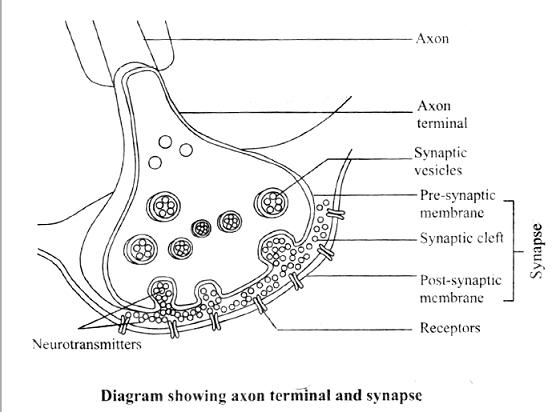
The axonal membrane is ___ to negatively charged proteins present in the axoplasm:-
A. Selectively permeable
B. Permeable
C. Semipermeable
D. Impermeable
Answer
500.7k+ views
Hint: Neurons are excitable cells because their membranes are in a polarized state. Different types of ion channels are present on the nerve membrane.
These ion channels are selectively permeable to different ions.
When a neuron is not conducting any impulse, i.e., resting, the axonal membrane is comparatively more permeable to potassium ions (
Similarly, the membrane is impermeable to negatively charged proteins present in the axoplasm.
Consequently, the axoplasm inside the axon contains a high concentration of K+ and negatively charged proteins and a low concentration of
Complete answer: The fluid outside the axon contains a low concentration of
These Neurons are excitable cells because their membranes are in a polarized state.
Different types of ion channels are present on the nerve membrane.
These ion channels are selectively permeable to different ions.

Additional information: When a neuron is not conducting any impulse, i.e., resting, the axonal membrane is comparatively more permeable to potassium ions (K+) and nearly impermeable to sodium ions (Na+).
1. Similarly, the membrane is impermeable to negatively charged proteins present in the axoplasm.
2. Consequently, the axoplasm inside the axon contains a high concentration of K+ and negatively charged proteins and a low concentration of
3. These ionic gradients across the resting membrane are maintained by the active transport of ions by the sodium-potassium pump which transports 3 Na+ outwards for 2 K+ into the cell.
4. As a result, the outer surface of the axonal membrane possesses a positive charge while its inner surface becomes negatively charged and therefore is polarised.
So the correct answer is D. Impermeable
Note: The electrical potential difference across the resting plasma membrane is called the resting potential.
At a chemical synapse, the membranes of the pre- and postsynaptic neurons are separated by a fluid-filled space called the synaptic cleft.
The rise in the stimulus-induced permeability to Na+ is extremely short lived.
It is quickly followed by a rise in permeability to K+.
Within a fraction of a second, K+ diffuses outside the membrane and restores the resting potential of the membrane at the site of excitation and the fiber becomes once more responsive to further stimulation.
These ion channels are selectively permeable to different ions.
When a neuron is not conducting any impulse, i.e., resting, the axonal membrane is comparatively more permeable to potassium ions (
Similarly, the membrane is impermeable to negatively charged proteins present in the axoplasm.
Consequently, the axoplasm inside the axon contains a high concentration of K+ and negatively charged proteins and a low concentration of
Complete answer: The fluid outside the axon contains a low concentration of
These Neurons are excitable cells because their membranes are in a polarized state.
Different types of ion channels are present on the nerve membrane.
These ion channels are selectively permeable to different ions.

Additional information: When a neuron is not conducting any impulse, i.e., resting, the axonal membrane is comparatively more permeable to potassium ions (K+) and nearly impermeable to sodium ions (Na+).
1. Similarly, the membrane is impermeable to negatively charged proteins present in the axoplasm.
2. Consequently, the axoplasm inside the axon contains a high concentration of K+ and negatively charged proteins and a low concentration of
3. These ionic gradients across the resting membrane are maintained by the active transport of ions by the sodium-potassium pump which transports 3 Na+ outwards for 2 K+ into the cell.
4. As a result, the outer surface of the axonal membrane possesses a positive charge while its inner surface becomes negatively charged and therefore is polarised.
So the correct answer is D. Impermeable
Note: The electrical potential difference across the resting plasma membrane is called the resting potential.
At a chemical synapse, the membranes of the pre- and postsynaptic neurons are separated by a fluid-filled space called the synaptic cleft.
The rise in the stimulus-induced permeability to Na+ is extremely short lived.
It is quickly followed by a rise in permeability to K+.
Within a fraction of a second, K+ diffuses outside the membrane and restores the resting potential of the membrane at the site of excitation and the fiber becomes once more responsive to further stimulation.
Recently Updated Pages
Master Class 9 General Knowledge: Engaging Questions & Answers for Success

Master Class 9 English: Engaging Questions & Answers for Success

Master Class 9 Science: Engaging Questions & Answers for Success

Master Class 9 Social Science: Engaging Questions & Answers for Success

Master Class 9 Maths: Engaging Questions & Answers for Success

Class 9 Question and Answer - Your Ultimate Solutions Guide

Trending doubts
Where did Netaji set up the INA headquarters A Yangon class 10 social studies CBSE

A boat goes 24 km upstream and 28 km downstream in class 10 maths CBSE

Why is there a time difference of about 5 hours between class 10 social science CBSE

The British separated Burma Myanmar from India in 1935 class 10 social science CBSE

The Equation xxx + 2 is Satisfied when x is Equal to Class 10 Maths

What are the public facilities provided by the government? Also explain each facility




